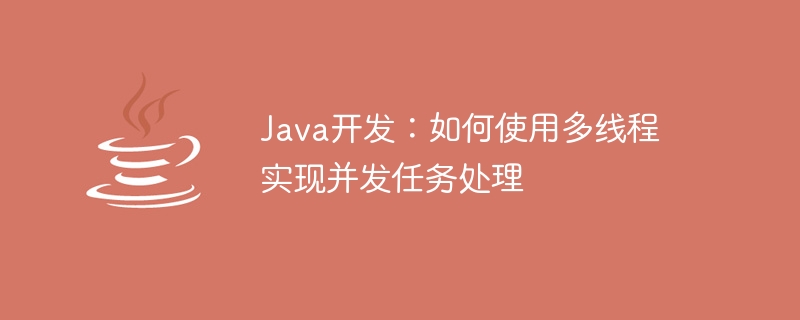
Java开发:如何使用多线程实现并发任务处理
引言:
在现代软件开发中,高效的并发任务处理是至关重要的。在Java中,多线程是一种常见且强大的方式来实现并发任务处理。本文将向您介绍如何使用多线程来实现并发任务处理,并附带具体的代码示例。
方式一:继承Thread类
public class MyThread extends Thread {
public void run() {
// 在这里写入线程运行时需要执行的代码
}
}
// 创建并启动线程
MyThread myThread = new MyThread();
myThread.start();方式二:实现Runnable接口
立即学习“Java免费学习笔记(深入)”;

新快购物系统是集合目前网络所有购物系统为参考而开发,不管从速度还是安全我们都努力做到最好,此版虽为免费版但是功能齐全,无任何错误,特点有:专业的、全面的电子商务解决方案,使您可以轻松实现网上销售;自助式开放性的数据平台,为您提供充满个性化的设计空间;功能全面、操作简单的远程管理系统,让您在家中也可实现正常销售管理;严谨实用的全新商品数据库,便于查询搜索您的商品。
 0
0

public class MyRunnable implements Runnable {
public void run() {
// 在这里写入线程运行时需要执行的代码
}
}
// 创建并启动线程
Thread thread = new Thread(new MyRunnable());
thread.start();ExecutorService executorService = Executors.newFixedThreadPool(5); // 创建线程池,指定线程数量为5
for (int i = 0; i < 10; i++) {
executorService.execute(new MyRunnable()); // 提交任务给线程池执行
}
executorService.shutdown(); // 关闭线程池在上述示例代码中,我们创建了一个固定大小为5的线程池。然后,我们循环提交10个任务给线程池执行。最后,我们调用shutdown()方法关闭线程池。
使用共享变量:
public class SharedData {
private int count;
public synchronized void increment() {
count++;
}
public synchronized int getCount() {
return count;
}
}
SharedData sharedData = new SharedData();
// 创建并启动多个线程
for (int i = 0; i < 10; i++) {
Thread thread = new Thread(() -> {
sharedData.increment();
});
thread.start();
}
// 等待所有线程执行完毕
Thread.sleep(1000);
System.out.println(sharedData.getCount()); // 输出结果应为10使用wait()、notify()方法:
public class Message {
private String content;
private boolean isEmpty = true;
public synchronized String take() {
while (isEmpty) {
try {
wait();
} catch (InterruptedException e) {
e.printStackTrace();
}
}
isEmpty = true;
notifyAll();
return content;
}
public synchronized void put(String content) {
while (!isEmpty) {
try {
wait();
} catch (InterruptedException e) {
e.printStackTrace();
}
}
isEmpty = false;
this.content = content;
notifyAll();
}
}
Message message = new Message();
// 创建并启动多个线程
Thread producerThread = new Thread(() -> {
for (int i = 0; i < 10; i++) {
message.put("Message " + i);
Thread.sleep(1000);
}
});
Thread consumerThread = new Thread(() -> {
for (int i = 0; i < 10; i++) {
System.out.println(message.take());
Thread.sleep(1000);
}
});
producerThread.start();
consumerThread.start();public class Counter {
private int count = 0;
public synchronized void increment() {
count++;
}
public synchronized void decrement() {
count--;
}
public synchronized int getCount() {
return count;
}
}
Counter counter = new Counter();
// 创建并启动多个线程
Thread incrementThread = new Thread(() -> {
for (int i = 0; i < 1000; i++) {
counter.increment();
}
});
Thread decrementThread = new Thread(() -> {
for (int i = 0; i < 1000; i++) {
counter.decrement();
}
});
incrementThread.start();
decrementThread.start();
incrementThread.join();
decrementThread.join();
System.out.println(counter.getCount()); // 输出结果应为0结束语:
使用多线程可以有效地实现并发任务处理。在本文中,我们介绍了如何创建线程、使用线程池、实现线程间的通信以及线程间的同步控制,并提供了具体的代码示例。希望这些内容对您在Java开发中使用多线程实现并发任务处理有所帮助!
以上就是Java开发:如何使用多线程实现并发任务处理的详细内容,更多请关注php中文网其它相关文章!

java怎么学习?java怎么入门?java在哪学?java怎么学才快?不用担心,这里为大家提供了java速学教程(入门到精通),有需要的小伙伴保存下载就能学习啦!

Copyright 2014-2025 https://www.php.cn/ All Rights Reserved | php.cn | 湘ICP备2023035733号